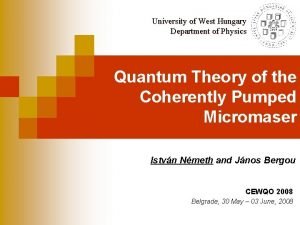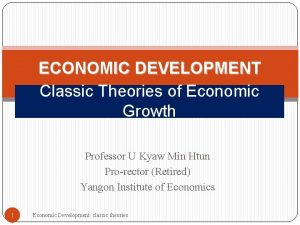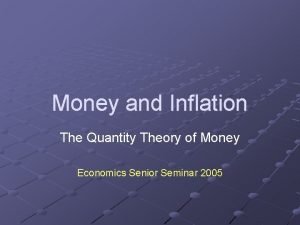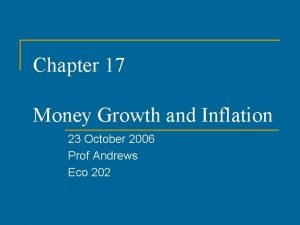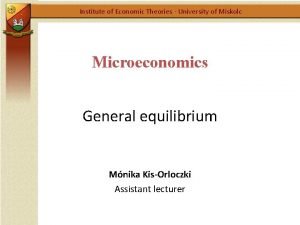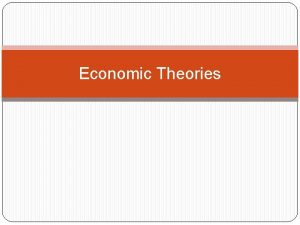Institute Of Economic Theories University Of Miskolc Hungary








































- Slides: 40

Institute Of Economic Theories - University Of Miskolc - Hungary Microeconomics Lecture 2 Mónika Kis-Orloczki Assistant lecturer

The analyses of consumers’ behaviour § Behaviour of households is a synonym to consumers’ behaviour § Household: A collective of cohabiting people, who make own decisions according to some order and tolerate the consequences together. § The decisions are influenced by: § § § Needs Income Price 2

Consumers’ decisions § The goal: To maximize the satisfaction of needs maximisation of utility. § Utility: the satisfaction derived from a consumption of a good. § The cardinal utility analysis: § The consumer is able to measure the utility in cardinal numbers. § Goods are comparable. § The utility of some goods is not a function of another good’s utility. 3

Total Utility (TU) Total utility (TU): The whole utility feeling gained by consuming a given amount of goods. U Fullness point 1 2 3 4 5 X 4

Marginal utility (MU): The change in the utility resulting from the consumption of a subsequent piece of goods. 5

Caracteristics of Utility § The more consumed quantity is, the more total utility is § The contribution of all the pieces of goods to the total utility shows diminishing tendency in the order of consumption. Hypothesis of diminishing marginal utility = Gossen’s First Rule § At a point fullness occurs, after consuming a number of products, the total utility is not growing, but decreasing § At the Fullness Point TU is at the maximum and MU=0 6

The optimum of consumption § In case of one good: until the fullness point § In case of 2 goods Theory of Equalization of Utilities Optimal consumption: MUx = MUy 7

Analysis of consumers’ preferences Axioms of preference ordering § Completeness: any 2 consumption bundles can be compared with each other § Reflexivity: the consumer can identify the consumption bundles and their utility § Transitivity : if utility. A>utility. B and utility. B>utility. C then utility. A >utility. C 8

Indifference curves § An indifference curve represents the points of those consumption bundles in the system of coordinates of two goods, which have the same utilities and they ensure the same consumption/utility level. § The indifference/preference map shows all the indifference curves in this system of coordinates. It represents the consumer’s preference ordering system. 9

Illustration of indifference curves 10

Characteristics of indifference curves § One can not intersect the other, § Drawing away from the origin the indifference curves represent higher utility levels, § The slope is always negative, § The normal indifference curves are convex to the origin. 11

Irregular indifference curves Perfect substitutes Perfect complements Neutral goods Goods with fullness point or harmful goods 12

Rate of Substitution § Rate of Substitution (RS): Represents the ratio of changing quantities of “x” for “y”, or the slope of the chord between two points (“A” and “B”) of the indifference curve. It means: 13

Marginal Rate of Substitution (MRS) Y A B C MRS § Marginal Rate of Substitution (MRS): Shows the rate at which the consumer is just willing to substitute one good(x) for another (y), not changing his Total Utility It is the slope of the curve in a tangential point (“A” or U “B”). RS X

The budget constraint § Consumption bundles: a combination of goods or services that a consumer typically buys together § The budget constraint means the points that represent those goods combinations, which are still purchasable in the coordination system of – ordinary two – goods and the money runs out fully. 15

The budget line § Recomposing: § The slope of the curve: Y I/Py I (budget line) I/Px X 16

Change in the income of consumers The line moves parallel, the slope will not change. Y I : original income I 1/Py I 1: increasing income I/Py I 2: decreasing income I 2/Py I 2/Px I 1 I I/Px I 1/Px X 17

Change in the prices of the goods There will be a change in the slope of the budget line Y I : original price I 1: decreased price of good x (Px 1) I/Py I 2: increased price of good x (Px 2) I 2 I/Px 2 I 1 I I/Px 1 X 18

Institute Of Economic Theories - University Of Miskolc - Hungary Microeconomics Lecture 3 Mónika Kis-Orloczki Assistant lecturer

The consumer’s optimal choice Gossen’s Second Rule Point B is the optimal combination of the two goods Y max=I/Py A B C U 2 U 1 I X max=I/Px 20

The changes of income and the optimal consumption § Conditions of examination: § Unchanged preference systems § Unchanged prices § Changing income 21

22

Income consumption curve (ICC) and the Engel curve § ICC curve: represents the points which show the connection between the changing income and the optimal consumption in a two-goods coordination system. § Engel curve: show the connection between the consumer’s income and the consumption of a good x. 23

§ Increasing income optimal consumption is on those indifference curves that represent higher and higher utility level. § Normal goods: slope of both ICC and Engel curve is positive 24

The relation among the consumption of inferior good and the changing income 25

Inferior goods § Inferior good: the consumption of which is decreasing as the income raises. § The consumer gets on higher utility level, but the inferior good’s consumption becomes less and less. § The steepness of ICC and of Engel curve is negative 26

The relation among changing prices and demand § The conditions of examination: § Unchanged preference system § Unchanged income § Only one good’s price is changing, the others are not. 27

28

Price Consumption Curve (PCC) § PCC : represents the points of changing consumption in the case of changing price in the two goods coordination system § Normal goods: increasing price of x, decreasing consumed amount of x. § Influence of changing price (Px)on the other product decreasing Px, the consumed amount of good y: § can be increasing if the goods are substitutes. § can be decreasing if the goods are complements. § If a price raises, the consumption gets on an indifference curve which represents lower utility level. 29

Individual demand curve § Individual demand curve: points which show the connection between the changing price and consumption of the good x. § The slope of the demand curve is negative in the case of normal goods so if the price is increasing, demand is decreasing § BUT!! If the slope of the demand curve is positive PARADOX PRICE EFFECT 30

Paradox price-effect § Quality-effect: higher quality=higher price. § Speculation-effect: If the prices are increasing, we count on a further increase, so we will buy more. § Veblen-effect: the prestige goods § Giffen-effect: The demand of good x will be higher beside of increasing price, if the price of the substitute product is increasing more. 31

Market demand curve § Market demand curve is the horizontal sum of the individual demand curves. § Horizontal because we are curious of the quantity of goods that the consumers are willing to buy. (quantity on horizontal axis) § The more consumers on the market, the flatter the market demand curve is. 32

The market demand curve 33

Elasticity 1. Income elasticity 2. Price elasticity 3. Cross-price elasticity 34

1. Income elasticity § The elasticity of the income: shows the ratio of the percental changes in income and demand. § It shows that how many percentage changes the demand, if the income of a consumer changes with one percentage 35

Elasticity of income § Normal goods § Inferior goods § Luxury goods § Every-day consumption goods 36

2. Elasticity of price § The elasticity of price shows the ratio of the percental changes in price and demand. § It shows that how many percentage changes the demand, if the price of a good changes with one percentage 37

. Elasticity of price § Normal goods § Paradox price effect § Non-elastic demand § Elastic demand 38

3. Cross-price elasticity § Cross-price elasticity: shows the ratio of the percental changes in one good’s price and another’s demand. § It shows that how many percentage changes the demand x, if the price of a good y changes with one percentage 39

Cross-price elasticity § Complement goods § Substitute goods § Indifferent goods 40
 Kodolányi jános university
Kodolányi jános university University of west hungary
University of west hungary Dualistic development thesis
Dualistic development thesis Iit miskolc
Iit miskolc E learning miskolc
E learning miskolc Bgok miskolc
Bgok miskolc Napelem piac magyarországon
Napelem piac magyarországon Szakképzési centrum miskolc
Szakképzési centrum miskolc Iit miskolc
Iit miskolc Neptun miskolci egyetem
Neptun miskolci egyetem Dr menyhárt szabolcs miskolc
Dr menyhárt szabolcs miskolc African institute for economic development and planning
African institute for economic development and planning Economic growth vs economic development
Economic growth vs economic development What is economic growth and development
What is economic growth and development Chapter 1 lesson 2 our economic choices worksheet answers
Chapter 1 lesson 2 our economic choices worksheet answers Was austria hungary a country
Was austria hungary a country Fitorex
Fitorex Hungarian costumes
Hungarian costumes Hungary inflation rate 1946
Hungary inflation rate 1946 Hungary 896
Hungary 896 Lakes in hungary
Lakes in hungary Hungary inflation rate 1946
Hungary inflation rate 1946 Slow growth age structure diagram
Slow growth age structure diagram Hungary
Hungary Randstad hungary jobs
Randstad hungary jobs Iatefl hungary
Iatefl hungary Ericsson hungary
Ericsson hungary Morgan stanley hungary
Morgan stanley hungary Facts about finland
Facts about finland Air cargo booking software
Air cargo booking software Sap hungary kft
Sap hungary kft Spain and portugal are located on which major landform
Spain and portugal are located on which major landform Transylvania sighet
Transylvania sighet Hungary 1956
Hungary 1956 Absolute location of budapest hungary
Absolute location of budapest hungary Christmas in hungary
Christmas in hungary Holocaust hungary
Holocaust hungary Hungary time
Hungary time Agod attila
Agod attila Sca laminating machine
Sca laminating machine What is the proper adjective for denmark
What is the proper adjective for denmark

